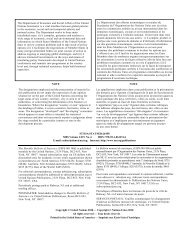dime NOTE The designations employed and the presentation of ...
dime NOTE The designations employed and the presentation of ...
dime NOTE The designations employed and the presentation of ...
- No tags were found...
You also want an ePaper? Increase the reach of your titles
YUMPU automatically turns print PDFs into web optimized ePapers that Google loves.
Employment, unemployment <strong>and</strong> earningsEmploie, chômage et gainsTechnical notes: tables 9-12Table 9: Unless o<strong>the</strong>rwise indicated, <strong>the</strong> data are fromlabour force surveys, refer to persons aged 15 years <strong>and</strong> over<strong>and</strong> to employees (wage earners <strong>and</strong> salaried employees)working on a specified day or during a specified week ineach month or quarter, or sometimes to <strong>the</strong> average numberworking during a given period.Mining <strong>and</strong> quarrying; manufacturing; electricity, gas<strong>and</strong> water; construction; wholesale <strong>and</strong> retail trade,restaurants <strong>and</strong> hotels; transport, storage <strong>and</strong> communication;financing, insurance, real estate <strong>and</strong> business services;community, social <strong>and</strong> personal services; activities notadequately defined.Table 10: Unless o<strong>the</strong>rwise indicated, <strong>the</strong> data arefrom labour force surveys, refer to persons aged 15 years <strong>and</strong>over <strong>and</strong> to employees (wage earners <strong>and</strong> salariedemployees) working on a specified day or during a specifiedweek in each month or quarter, or sometimes to <strong>the</strong> averagenumber working during a given period.Table 11: Unemployment generally represents <strong>the</strong> totalnumber <strong>of</strong> persons wholly un<strong>employed</strong> <strong>and</strong> temporarily laid<strong>of</strong>f.<strong>The</strong> data are derived from (a) labour force samplesurveys, (b) employment <strong>of</strong>fice statistics, (c) <strong>of</strong>ficialestimates <strong>and</strong> (d) insurance records. In using <strong>the</strong>se series,consideration should be given to <strong>the</strong> source <strong>of</strong> <strong>the</strong> data. Ingeneral, <strong>the</strong> figures relating to percentage un<strong>employed</strong> arecalculated by expressing <strong>the</strong> number <strong>of</strong> un<strong>employed</strong> in agiven period as a percentage <strong>of</strong> <strong>the</strong> total number <strong>of</strong> <strong>employed</strong><strong>and</strong> un<strong>employed</strong> persons in <strong>the</strong> group considered during <strong>the</strong>same period.Table 12: Earnings in manufacturing generally relateto <strong>the</strong> average earnings <strong>of</strong> wage earners in manufacturingindustries. Earnings normally include bonuses, cost <strong>of</strong> livingallowances, taxes, social insurance contributions payable by<strong>the</strong> <strong>employed</strong> person <strong>and</strong>, in some cases, payments in kind,<strong>and</strong> normally exclude social insurance contributions payableby <strong>the</strong> employers, family allowances <strong>and</strong> o<strong>the</strong>r socialsecurity benefits. <strong>The</strong> time <strong>of</strong> year to which <strong>the</strong> figures referis not <strong>the</strong> same for all countries. Unless o<strong>the</strong>rwise noted, <strong>the</strong>source <strong>of</strong> <strong>the</strong> data is from labour-related establishmentsurveys, <strong>and</strong> <strong>the</strong> data refer to employees <strong>of</strong> both sexes,irrespective <strong>of</strong> age.Some <strong>of</strong> <strong>the</strong> series do not conform to <strong>the</strong> above for oneor more <strong>of</strong> <strong>the</strong> following reasons: different type <strong>of</strong> source orcoverage, inclusion <strong>of</strong> non-manufacturing industries <strong>and</strong> use<strong>of</strong> wage rates, instead <strong>of</strong> earnings.For fur<strong>the</strong>r details on tables 9 - 12, see <strong>the</strong> Yearbook <strong>of</strong>Labour Statistics <strong>of</strong> <strong>the</strong> International Labour Office <strong>and</strong> <strong>the</strong>websites:http://laborsta.ilo.org;http://laborsta.ilo.org/applv8/data/bulempe.html;http://laborsta.ilo.org/applv8/data/c3e.html;http://laborsta.ilo.org/applv8/data/bulwage.html.Notes techniques : tableaux 9-12Tableau 9 : Sauf indication contraire, les donnéesproviennent d'enquêtes par sondage sur la main-d’œuvre, seréfèrent aux personnes âgées de 15 ans et plus et aux salariés(ouvriers et employés) travaillant pendant un jour ou une semainedonnés de chaque mois ou trimestre ou parfois au nombre moyendes personnes travaillant durant une période déterminée.Industries extractives; industries manufacturières; électricité,gaz et eau; construction; commerce de gros et de détail, restaurantset hôtels; transports, entrepôts et communications; banques,assurances, affaires immobilières et services aux entreprises;services à la collectivité, services sociaux et personnels; activitésmal désignées..Tableau 10 : Sauf indication contraire, les donnéesproviennent d'enquêtes par sondage sur la main-d’œuvre, seréfèrent aux personnes âgées de 15 ans et plus et aux salariés(ouvriers et employés) travaillant pendant un jour ou une semainedonnés de chaque mois ou trimestre ou parfois au nombre moyendes personnes travaillant durant une période déterminée.Tableau 11 : Le chômage représente, en général, le nombretotal des chômeurs et des personnes temporairement débauchées etproviennent (a) des enquêtes par sondage de la main-d’œuvre, (b)des statistiques des bureaux de placement, (c) des estimations<strong>of</strong>ficielles et (d) fichiers des assurances. En employant ces séries,il faut tenir compte de la source des données. En général, pourétablir les pourcentages de chômage, on calcule le rapport entre lenombre des ouvriers en chômage pour un groupe donné, pendantune certaine période, et l’effectif total des personnes employées etdes chômeurs dans ce groupe, pendant la même période.Tableau 12 : Gains dans les industries manufacturières serapportent en général aux gains moyens des ouvriers dans lesindustries manufacturières. Les gains comprennent normalementles primes, les allocations de vie chère, les impôts, lescontributions des ouvriers au fonds d’assurance sociale et danscertains cas, les paiements en nature, ils excluent normalement lescontributions des employeurs au fonds d’assurance sociale, lesallocations familiales et autres prestations de la sécurité sociale. Lapériode de l’année correspondant aux données varie d’un pays àl’autre. Sauf indication contraire, la source des données estd'enquêtes auprès des établissements liés au travail, et les donnéesse rapportent aux employés des deux sexes, considéré quel que soitleur âge.Certaines de ces séries s’écartent des normes indiquées cidessuspour l’une ou les raisons suivantes : type de source ou de lacouverture, l’inclusion d’industries autres que manufacturières etl’emploi, dans les calculs, de taux de rémunération au lieu degains.Pour plus de détails sur les tableaux 9 à 12, voir l’Annuairedes Statistiques du Travail publié par le Bureau International duTravail et les sites Internet :http://laborsta.ilo.org/default_F.html ;http://laborsta.ilo.org/applv8/data/bulempf.html ;http://laborsta.ilo.org/applv8/data/c3f.html ;http://laborsta.ilo.org/applv8/data/bulwagf.html.October 2010 – octobre 2010 98












